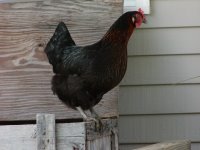
Here is a picture of "Lucy". She is one of two Black sex-link hens that we hatched in our incubator last spring (2005) and raised from a tiny chick. Her coop mate is "Ethel", both named from characters on the 1950s television series "I Love Lucy". We also kept a Buff Orpington cockerel - Ricky, which added a nice contrast color, as well as HIS antics and personality. Sadly roosters are NOT allowed in the town we live in, and as he matured so did his voice! I admit he was quite loud and would often start his revelry at pre-dawn. This obvious did NOT sit well with one of our neighbors who filed a complaint with Animal Control. Regretfully we had to get rid of him. We found him a nice home where he's been for over a year with many, many hens. Sadly, we just learned that he was killed by a coyote in broad daylight...
The "Sex-link" chicken is one, which at time of hatch, can be sexed by its color. The Black "sex-link" is a great brown egg layer and has a wonderful disposition.
I am currently in the process of building them a suitable, predator proof coop - one that will be permanent and allow the girls to come and go as they please. However, for now they are housed in a large wooden crate, that's kept up against the back of the house. As a result we have a daily routine where by in the mornings we carry them out back to a temporary coop, which is housed under the rabbits (I'll post an entry on the rabbits at another time), and then in evenings we carry them back to their wooden crate-coop. As a result of this process, both, Lucy and Ethel have become surprisingly friendly and accepting of the entire process. We do not have to chase after them to catch them, they simply allow us to walk up to them and pick them up.
Building the temporary coop under the rabbits has proven to be a great idea. Not only does it allow us to keep these animals in the same area, which is much easier on the feeding and watering but also fany ood, treats etc. that fall thought the rabbit cages get a second chance at being consumed by Lucy and Ethel. They are also very good at keeping the rabbit droppings, food, hay, grass etc mixed with their constant scratching and digging. This makes for a nice mixed compost and allows immediate transfer to our flower beds, shrubs and trees, which are showing their satisfaction with nice growth and beautiful colors this year.
On Sunday June 25 I attend a small animal flea market that was held at a local Sportsman club. This flea market is held once in the spring and once in the fall and is a great place to pick up a critter or two - and with that said I did! In an effort to create a nice variety of poultry in our backyard coop I bought a Barred Rock pullet. Barred Rock's are prolific layers of brown eggs, and are not discouraged by cold weather, which is perfect for our cold New England winters. This gal has been named "New Honey" by our 4 year old daughter. The tricky part now is to be able to cage her with Lucy and Ethel. However, they want NO part of that! They are all to eager to set the proverbial pecking order and with that they are mean and relentless. So for now they need to be kept separated but we're working on getting them acquainted.
We are also once again running the incubator, which holds 42 eggs. Chicken eggs take 21 days to hatch, so this batch is due on Saturday, July 8 - right around the corner. This time, however, we are incubating Buff Orpington and Black Langshan eggs, which will add even more variety and color to our backyard poultry coop.
Poultry terms and definitions:
- Pullet - A female chicken under 1 year of age.
- Hen - A female chicken, greater than 1 year old.
- Cockeral - A male chicken under 1 year of age; also called young rooster.
- Rooster - A male chicken, greater than 1 year old.
- Broiler - A broiler is a chicken raised primarily for meat, as opposed to a one raised to produce eggs.
- Capon - A castrated male chicken.
- Fryer - A young chicken that is 9 to 12 weeks old and weighs from 3 to 4 pounds.
**** Update 07/12/2006: The eggs in the incubator began hatching this past Friday night. The first little guy out was one of the Leghorn/Orpington crosses. Sadly to report only 7 eggs out of the 42 hatched - what a terrible percentage. Here's the break down:
- 2 eggs bad and removed during the incubation period leaving 40.
- Of the 7 that hatched: (1) chick died, (1) chick had to be destroyed & (5) are fine.
- The five are: (1) Langshan, (2) Buff Orpingtons & (2) Leghorn/Orpington crosses
**** Update 07/31/2006: The chicks are just over 3 weeks old now; they're doing fine and growing fast. With the warm weather, we removed their heat lamp 2 weeks ago - it's not needed. It's still too early to tell, for me anyway, but it looks like there are 2 cockerals; one Orpington & one Leghorn cross, and three pullets.
No comments:
Post a Comment